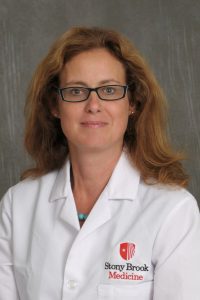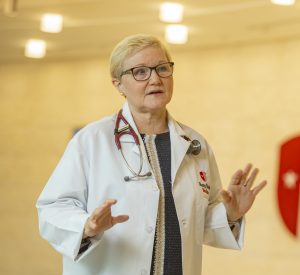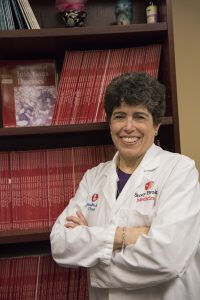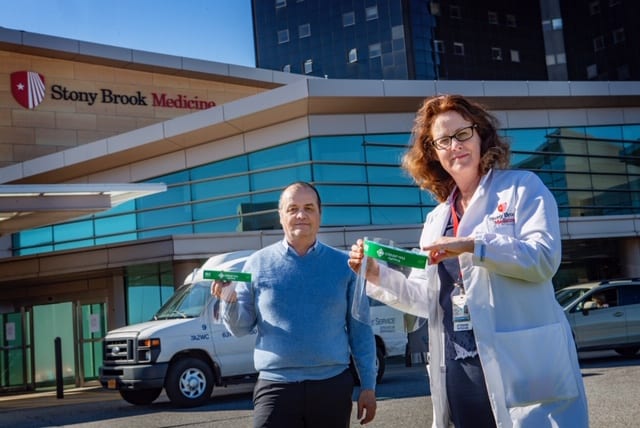Previously invisible to most of the public, the infectious disease team at Stony Brook Medicine took center stage from the beginning of the pandemic in 2020 through today as area residents have battled COVID-19 and other diseases.
With a peak of over 500 people hospitalized at Stony Brook University Hospital with COVID-19 in 2020, the combination of Drs. Bettina Fries, Susan Donelan and Sharon Nachman provided best practices to protect hospital staff and patients, gathered information about the developing virus and communicated through the media with a public desperate for information.
Working with teams of other dedicated health care professionals, these infectious disease doctors helped treat and save numerous patients.
TBR News Media is pleased to name Fries, Donelan and Nachman as People of the Year for 2022.
“Stony Brook Hospital got all kinds of kudos during the height of the pandemic,” said Dr. Jonathan Buscaglia, chief medical officer at Stony Brook University Hospital. “When you’re going through a hurricane crisis, you need somebody who has a clue about hurricanes to lead you. Those people were our leaders.”
At the time, the team of infectious disease doctors impressed their colleagues not only with their effectiveness, but also with their tireless work.
“When COVID happened, it was a calling” for these infectious disease experts, Buscaglia said.
In the beginning of the disease, little was known about the most effective treatment, which meant doctors from several departments came together to create a standard protocol.
The infectious disease faculty “contributed significantly” to develop these practices, said Dr. Vincent Yang, chair of Medicine at the Renaissance School of Medicine at SBU.

Dr. Bettina Fries, the chief who served on the front lines
Chief of the Division of Infectious Diseases at Stony Brook Medicine, Fries is a “nationally if not world-renowned physician scientist,” Buscaglia said.
As with her colleagues, Fries works directly with sick residents.
Fries “100% served on the front lines to care for all the hospitalized patients with COVID,” said Buscaglia, which included working seven days a week for weeks on end. She guided her staff and helped other physicians.
Early on, Fries was also “instrumental in getting a manufacturer of face masks to donate a significant number to the hospital,” Yang said. This was a key part of the personal protective equipment that had been scarce during the unsettled early part of the pandemic.
Yang described her as “highly motivated, energetic and forward thinking” and believes she is a “wonderful leader” who is detail oriented. Fries provides clear expectations for people who work for her and is an avid educator, Yang added.
As an expert in using monoclonal antibodies to treat various bacterial infections, Fries helped direct an effective therapy using these antibodies for COVID patients, according to Yang.
Fries and her team were also involved in consulting on patients, not just for COVID but also for secondary infections, Yang said.
Connie Kraft, emergency manager in the Emergency Management Office at SBUH, described Fries as “very personable” and appreciates how she studies scientific data to crunch the numbers.

Dr. Susan Donelan, a ‘hero’ who lost sleep to help patients
Donelan, who earned her bachelor of science degree from SBU, is medical director of Healthcare Epidemiology at Stony
Brook Medicine.
In addition to caring for patients, Donelan also worked to avoid the spread of COVID at the hospital, reducing the risk to staff and to Long Islanders who came to the hospital for other medical needs.
“We don’t want patients coming in without COVID getting it while they’re here,” Buscaglia said. “It takes a special person to guide the rest of us.”
The hospital established a forward triage effort, which provided an initial assessment of COVID patients outside the hospital.
Kraft appreciated Donelan’s commitment to safety throughout the halls of the hospital.
“If you’re somebody who is walking down the corridor and your mask is hanging off your face, [Donelan] didn’t care who you are. She’s going to stop you and say, ‘Hey, pull your mask up,’” Kraft said.
As a subject-matter expert, Donelan was “our hero,” Kraft added.
Specializing in the latest treatments and symptoms, Donelan also helps faculty and staff with medical questions.
When Kraft’s grandson was sick, she asked Donelan for advice.
“She was right there, giving me support,” Kraft said, which gave “everybody a sense of calm.”
A tireless worker, Donelan often appeared on Zoom calls even during her time off.
She “doesn’t stop thinking about ways to help patients,” Buscaglia said. She “literally loses sleep about it.”

Dr. Sharon Nachman, active in front of the camera and behind the scenes
Nachman, who earned her medical degree at SBU, is chief of the Division of Pediatric Infectious Diseases at Stony Brook Children’s.
Often visible during her appearances on local broadcast news channels and in numerous local publications, including TBR News Media, Nachman is committed to ensuring the public receives accurate information.
“Giving people information about why it’s important to wear masks, wash their hands and get vaccinated, those are the things that affect the community,” said Dr. Carolyn Milana, chair of the Department of Pediatrics at Stony Brook Children’s.
Even though Nachman is a pediatrician and works at the children’s hospital, she, like so many other doctors, helps wherever it is needed, which in the early days included caring for adults.
Nachman was “instrumental from the adult and pediatric perspective making sure we had the latest and updated information about how to treat those patients,” Milana said. “She and her team were out there [checking] on all the patients to make sure they were all cared for the same.”
In addition to helping to get COVID vaccine trials up and running at Stony Brook, she has been active in trials to treat monkeypox.
Milana appreciates Nachman’s approach to children and their parents.
“She’s super friendly with kids,” Milana said. “She’ll tell you the facts as they are. She’s straightforward with parents. She wants them to have all the information they need to make the right decisions.”






